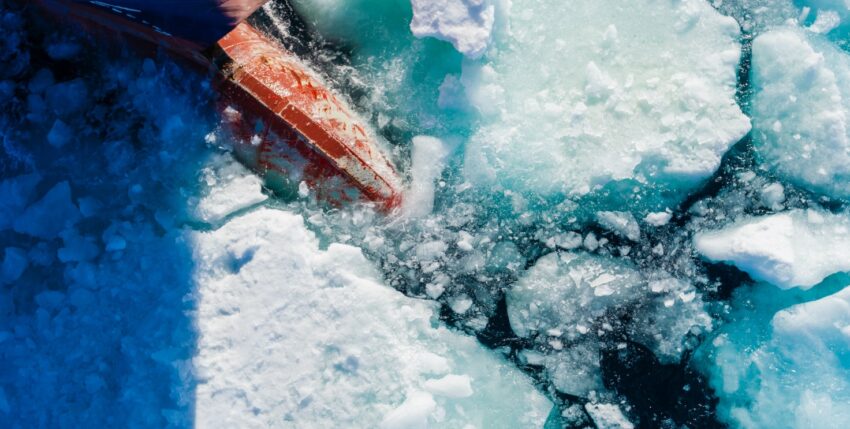During the Cold War, the Arctic just as quiet as in other regions of Europe, so there was no trace of "exceptionalism" here either. During these decades, the High North was probably the largest, above all nuclear "powder keg" in the world, because for Moscow, in view of the difficult-to-cross straits of the Belts and the Bosporus, the North Sea was the only available gateway to the vastness of the North Atlantic. Consequently, not only was a three-digit number of submarines and surface ships stationed here, but the Kola Peninsula also became the largest deployment area for Soviet nuclear weapons. In addition to numerous tactical nuclear warheads, the concentrated strategic second-strike capabilities in the form of the Soviet SSBN fleet were located here, which were to find a secure "bastion", as the concept was called, in the Soviet-controlled Arctic Ocean. In order to protect this, the USSR wanted to prevent any activity by enemy forces by all means and well in advance of the Barents and Kara Seas. To this end, the entire Soviet Arctic coast was equipped with a large number of bases, even if these could only form a string of pearls of early warning systems and air defences over a distance of around 8000 km as the crow flies.
At the end of the Cold War, a period of disarmament and détente began which, in retrospect, was rather short and from which the image of Nordic uniqueness emerged. But after barely two decades, this beautiful image of a conflict-free North began to show cracks: When the Russian Chilingarov expedition placed the flag of the Russian Federation on the seabed of the geographic North Pole at the beginning of August 2007 in a spectacular operation involving two manned deep submersibles, thereby symbolically seizing ownership, an outcry went around the world. Although a nullity under international law, the West was alarmed by the Russian action. This was followed remarkably quickly by the so-called "Illulissat Declaration" of May 2008, in which the Arctic littoral states, from then on known as the Arctic 5 (Canada, USA, Russia, Norway and Denmark because of Greenland) mutually committed to respecting international maritime law and the peaceful settlement of conflicts in the Arctic Ocean. As a side effect, they also achieved the positive side effect of keeping all other states out of the region, as the International Law of the Sea (UNCLOS) contains extensive regulations on the delimitation of territories and the settlement of competing claims of neighbouring states to marine areas, but in no way authorises them to make more exclusive claims to other parts of the high seas. This is and remains legally the "common heritage of mankind" and is subject to a set of rules under the supervision of the United Nations.
After a wave of media hype and popular science publications, most of which warned of major emerging conflicts in the context of Arctic resource abundance - the U.S. Geological Survey had published its vague estimate of the 13% of global oil and 30 % of global gas reserves in the Arctic. Arctic published - public interest died down again. However, the Russian annexation of Crimea brought concerns about dangers from the east back onto the agenda everywhere from 2014 onwards, including in the Arctic. Today it is becoming increasingly clear that the Arctic peace ad infinitum is as eternal as its ice. Both seem to be in human hands now, the fate of "nature" as well as that of the peoples and their coexistence.
There are good reasons why climate change and the associated phenomenon of the melting Arctic ice sheet is a problem that is constantly reflected in the media. And as much as the topic seems to be overdone, it must be clearly stated: In the Arctic climate change is massive, and it is occurring at over two and a half times the speed and intensity of other regions. This has to do with a number of factors, above all the albedo of the ice sheet, because the white ice surface reflects the sunlight, but the dark ocean absorbs it, creating a vicious cycle of melting and further accelerated warming. The areas of the Arctic still covered by ice in summer have decreased from an average of over 7 million square kilometres to just over 5 million square kilometres within a few decades. There can be no doubt that this fact describes a reality with potentially serious ecological consequences and that the current trend of this change is even more dynamic. This is also the greatest driver of political change in the Arctic. There is no doubt that the opening of new sea routes in the Arctic, which may soon be uncomplicated and navigable all year round, will also have security implications. Added to this is the aforementioned unrest between West and East in the wake of the Ukrainian developments, and other (power) shifts in the competition between the leading (maritime) powers also play a major role.
The question of new sea routes, which has been discussed in many places, is of some importance: it is obvious that with a considerable reduction in the Arctic ice pack, the possibilities for maritime transport utilisation will increase, basically on 3 routes: Northwest, Northeast and Transpolar Passage. The Northwest Passage (NWP) is likely to be of little importance. What is to be shipped in large quantities via the Canadian Arctic Archipelago and to what destinations? The situation is different with the NOP or the Northern Searoutewhich could indeed provide a significant shortcut to the main global shipping routes between Asia and Europe. The transpolar passage is entirely new, and is currently still completely unthinkable for commercial purposes, but if the current trend of melting of the Nordic ice sheet continues, the polar ice cap could become ice-free in summer from the 2030s.
Which powers are currently Arctic relevant? Denmark and Norway are left out of the Arctic 5 because they are clearly not great powers, and Canada is only briefly touched on. Although the country is an important Arctic player and the NWP runs through the Canadian archipelago, the country is still a long way from being a great power, despite its great Arctic ambitions. The construction of new Canadian Arctic Offshore Patrol Vessels (AOPV), which is taking place with great delay, does almost nothing to change this; these are rather symbolically armoured. The type ship of the new Harry de Wolf class has been in trial operation since the end of 2019. This class can be used for patrols, but it cannot be used for naval operations in any way.
The remaining relevant players in terms of power politics are Russia, the USA - and the People's Republic of China, which declared itself a "Near Arctic State" two years ago and is increasingly developing Arctic activities.
To put it simply, it can be said of these three superpowers that the USA is experiencing something of an at least partial Arctic awakening after a long period of abstinence in the High North. It can also be said that the Russian Federation, despite the Cassandra-like rhetoric that has been used in many places, is at least a threat in the High North. überand the People's Republic of China in its future role in contrast clearly underis estimated. The observations and assumptions that support these assessments will be examined in more detail in the following instalments of this series of articles, so here are just a few comments in advance:
The USA, the world's only remaining superpower, was rightly described as "remarkably weak" in its Arctic ambitions not so long ago. To the surprise of some, even the new "National Defence Strategy of the United States of America" under the aegis of James Mattis from January 2018 did not even mention the region. A rethink is now underway. The crises surrounding Ukraine and Syria can be seen as an accelerator of an Arctic change of heart in the USA. This is also demonstrated by the construction of new icebreakers, which has now actually begun, albeit hesitantly, as well as activities such as the large-scale NATO manoeuvre "Trident Juncture 18" or the re-establishment of the "2nd Fleet Regional Command" in Norfolk, which is responsible for the entire North Atlantic.
The addressee of these efforts, Russia, is currently perceived as a threat by most Western governments. This is understandable, as the annexation of Crimea, the war in Donbass, the intervention in Syria and the sometimes sabre-rattling behaviour of the Putin government have increased considerably in recent years and are not exactly confidence-building. But what is the structural basis of Moscow's behaviour in the High North? The fact is that the Russian Federation has no small number of bases in the Arctic reopened or built new ones. However, the level of militarisation from the Soviet era has not yet been reached. As in Soviet times, the harbour and base cluster around Murmansk and Severomorsk forms Russia's maritime gateway to the Barents Sea and North Atlantic and contains the second-strike capabilities of the Russian SSBN fleet. Most of the other bases off Russia's coastline are small installations. Above all, however - as will be shown - Russia is dependent on new production areas and offshore deposits in its Arctic coastal region to an unprecedented extent. The development of the Yamal Peninsula, the liquefaction plants, the Sabetta export harbour and other projects, which are being pursued with great vigour and a high level of funding, demonstrate the extreme dependence of the Russian economy, and even more so the state budget, on the undisturbed exploitation of these resources and the oil generated there. cash flow from the export of hydrocarbonates. Russia has no use for political turbulence in this region.
The third, often underestimated Arctic player is the Chinese, who have only recently become visible on the scene. In January 2018, China declared itself a "Near-Arctic State" with the publication of its Arctic White Paper, although even the northernmost border areas of Manchuria are still around 1,500 km away from the Arctic Circle, which cuts through Siberia, and Chinese ports south of Vladivostok have to travel thousands of kilometres to reach Arctic waters.
China has been underpinning this claim for several years with increased activities. Chinese capital is also heavily involved in the development of Russian export complexes for liquefied natural gas. While the West has now withdrawn from these activities, Chinese state investors are only too happy to step in and now hold a substantial stake of around 30 % in the 27 billion $ LNG-2 project, which was launched in 2018. The least favourable reception in Western security circles, however, is caused by the increasing Chinese economic activities in communities such as Iceland and Greenland, in the former case controlled by an embassy of hundreds of people in Reykjavik. There is a danger here that entities that are smaller in number or striving for independence will enter into co-operation with a partner that they are in no way a match for, let alone at the negotiating level. The latest concerns also relate to the question of closer military co-operation between the Russians and the Chinese; this will also be discussed in one of the next episodes of the Marine Forum.
The author is Senior Fellow at the Institute for Security Policy at the University of Kiel and, among other things, editor of the "Handbook on Geopolitics and Security in the Arctic", soon to be published for the first time by Springer.










